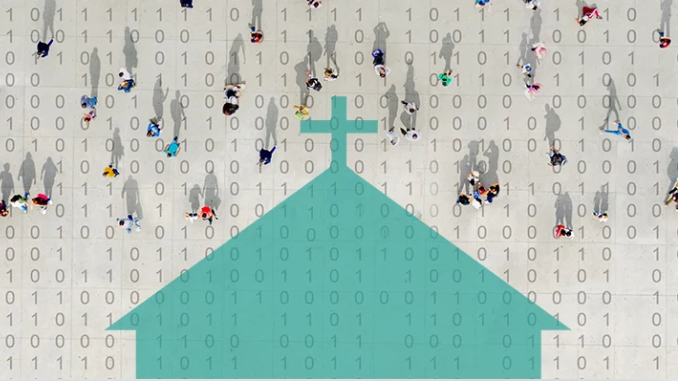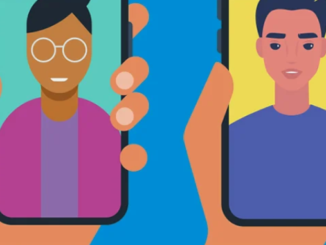
We will remember this year for many reasons. Among them, it will be known as the year the church closed its doors while simultaneously claiming new space in the digital world—and living rooms across the country. Churchgoers worshipped from home and church leaders wondered if Easter 2020 might break the internet. Now we’re wondering the same thing about Christmas.
For some churches, a new or expanded digital ministry has served as a life raft, keeping them afloat and in touch with their congregations and communities. Others had been embracing digital tactics, but more as a stop-gap measure rather than a strategic plan. It’s been a year of adapting, of trying, and trying again.
Now church leaders face a pressing question: What should ministry look like going forward? How do we sustain and expand the impact of our in-person and digital ministries? What do we hold on to? What do we let go of? How do we measure success?
Welcome to the era of the phygital church.
What is Phygital?
Across our culture, retailers and organizations have embraced the idea of phygital marketing and business models that meld physical and digital experiences. It is no longer a matter of either/or; instead, it is both/and.
For example, when you visit an amusement park, you can choose to purchase tickets online or at the gate. Within the park, you access the park app to explore schedules, featured shows, dining options, and ride wait times.
The physical and the digital experience work in tandem, complementing one another and creating a more personalized, memorable, and engaging guest experience. Phygital experiences provide choices and decrease the delay between the call to action and the next step.
Greg Snider, Ministry Space Strategist at Aspen Group, illustrates the idea. “We’ve all learned how to do both digital and physical. For example, we no longer walk up to a hotel counter and say, ‘Do you have a room available for tonight?’
“Southwest Airlines invites you to download their app so you can access movies and entertainment on your device instead of the plane’s devices. I’m not experiencing Southwest digital independently. It’s an integrated experience. With Southwest, Hilton, and Starbucks, three businesses I interact with online and in-person, I check-in digitally, track points digitally, then board a plane, or arrive at my room, or pick up my coffee order.”
Aspen Group has been exploring possibilities with churches seeking to expand their discipleship impact through integrated onsite and online experiences. “Within churches, we’ve realized that digital has the potential to introduce people to the gospel—to help people find their way back to God,” says Greg. “Some people may never step foot in a church; people tune into digital for various reasons. It’s a means for reaching more people and creating a robust experience that accommodates the way we do life now.”
Phygital for Church Planters
Recently, Evan McBroom, Aspen’s VP of Marketing and Business Development, explored the idea of phygital ministry further with Greg Snider and Stadia, whose mission is to plant churches that intentionally care for children, focusing on preparing leaders to start healthy churches that intentionally reach the next generation of believers.
Joining us for the conversation were Stadia’s VP of Culture and Team Development, Janie Mehaffey, and Director of Digital Church Planting, Jeff Reed. Jeff joined the Stadia team earlier this year to support leaders by applying his 20 years of digital and technological experiences, recently with The Church Digital, to help churches maximize digital ministry impact. Little did the team know how perfect the timing would be to help churches respond even more rapidly in this season.
Janie shares their team was also pivoting in their thinking: “We needed to decide to make an intentional shift to focus on the existing church. Stadia is a church planting organization, so our primary work is coming alongside the existing church to say, how can we facilitate the church advancing through new church expressions?
“We realized that for churches in the future to thrive, we needed to make sure that the church is thriving now. [We looked at what we could] do to use our resources, innovation, and the expertise we had to come alongside the existing church and make that a conversation. So, our team quickly gathered to help.”
From Stadia’s perspective, phygital ministry is “not a replacement of community, but a birth of a new kind of community. Phygital ministry uses technology as a tool to complement the mission of the church in both the physical and digital realms – to grow across multiple contexts, and to multiply everywhere that people gather, online or in person.”
The Stadia team began meeting with ministry partners to share ideas and learn from one another’s experiences and later moved to launch Phygital Learning Communities, where churches can learn from experts and one another. I participated in Stadia’s first phygital cohort and heard firsthand the questions and challenges church leaders are facing. The exchange of ideas and support that church planters were able to share with each other gave me hope for the future of the church.”
“The collaborative effort of what’s happened has been just fascinating,” says Janie. “Adding in what Jeff had been researching and learning for years has become a great experiment. Jeff is like the mad scientist in the lab, but what’s amazing is that it’s not just science or guessing. It’s all very Holy Spirit led. There is no doubt that God is doing a major movement in the church. That’s scary to a lot of people because it’s new and it’s different. But, it’s going to truly reach the whole world because of the changes that are being made.”
4 Ways to Adopt a Phygital Mindset
If your church wants to adopt more of a phygital ministry mindset, here are four things to consider as you get started:
1. Start with Vision
Jeff shares, “The first thing to consider when taking on a phygital mindset is understanding the church’s or organization’s overall goals. We’re discovering that pre-COVID, the church had a very strong bias towards the physical space. Some churches were broadcasting services online, maybe around 10% or so, but when it came to creating disciples, even simple things like small groups were not happening in the digital space. Now, we’re seeing well over half of the churches doing something in the digital space. Maybe it’s not the full gamut of ministry, but they are moving more into the space.”
Declare your purpose, then seek to help your church live on mission by integrating your physical and digital experiences to fully support your ministry’s goals. Jeff notes that ultimately as churches consider their focus, they are going to have shared purposes. “Ideally, it’s the Great Commission—creating disciple-makers. Whether that is done physically or digitally doesn’t matter in the end. Let’s focus on creating disciple-makers.”
2. Define the One
Stadia encourages churches to lean into the idea of going after the one, modeled in Jesus’ parable of the lost sheep in Luke 15. “If you’re talking about doing digital ministry and reaching people digitally, I would challenge you to do two things,” says Jeff. “Come up with a ‘one.’ If you’re trying to reach people online, there are so many people. It’s broad, and there are many different interests and ways to reach them. If you just do a shotgun approach online, you’re going to lose them. You’re not going to hit anybody. Fine-tune the type of person and create a persona for that person. Put a name on it. For example, you might say I’m trying to reach Susie, who is a soccer mom. Or, I’m trying to reach Jorge. He’s a 32-year-old dad. Come up with that personality. Figure out what they’re doing digitally and put your marketing and energy toward that.
“Then, I would go a step further because there are institutional ones, but there are also individual ones. People in your church have a circle of influence digitally. What if we ask these people to evangelize and share? What if we trained them to create disciple-makers and then unleashed them on their ones on Facebook? This is where I think the church really grows post-COVID. Carey Nieuwhof wrote a blog recently about how evangelism has changed. We’re going to have to adjust the mindset and start to get out of the idea of creating these mega services. What if we empower our people to share, and we grew that way?”
3. Embrace Each Strategy’s Superpowers
Physical: Jeff notes that often the people whom churches are trying to reach are seeking convenience, whether it’s in the physical or digital space. “There is a place for physical space. The strength of the physical location is to meet people. When the service is over, the first-time guests stand up and your church has 47 volunteers, church staff, or pastors positioned between them and the parking lot. You’re asking, ‘How can I pray for you?’ There are gift bags, sign-ups for small groups, and connection cards. There are whole industries centered around the idea of discovering who the people are that are in your physical space.”
He also points out that the convenience factor begins to break down after that initial in-person contact. “How long does it take that person who signed up for a small group to actually attend? How many times do you have to call and remind them to show up? Or what about the person who wants to serve, but doesn’t make it through all three training sessions to the point of service? Or the person who wants to be a member but drops out after the second class?”
Digital: On the digital side of ministry, it’s easier to move through those kinds of intentional processes when they can happen on demand. Jeff adds, “It’s very easy to sign up for or to attend an online small group. The majority of small groups I’ve led in my life are at 9 p.m. after the kids go to bed. I don’t have to haul them all over the city. Serving online is typically done on your schedule when you’re available. Going through a membership class online, once again, is super easy as well.
“Really the struggle, the hardest part of all of church online, is when it comes to discovering who the people are who are watching these services. This is one of the multiple digital mindsets you could have: What if we married together the physical service where we discover who people are and the digital discipleship pathway to help streamline a church toward making disciple-makers? That is the ultimate goal of what the church is trying to do.”
4. Have Team Conversations
As you consider the conversations that your team should be having about implementing a phygital ministry strategy, start with the following questions:
- What are the things that need to happen within your physical space?
- How could your physical space enhance the digital worship experience?
- What are the things that should continue (or start) to happen digitally?
- How can you learn to engage digital tools that will make the physical experience more enjoyable and vice versa?
- How could digital accelerate ministry opportunities through automation and more convenient processes?
“Church is meant to be a lifestyle—something we do day in and day out. My phone is with me day in and day out,” says Greg. “We have to think in terms of how to connect people in a way that’s engaging people where they are every day, which is on their phones. Just like we can set a reminder to get our steps in for the day, we can set reminders about church and ministry opportunities so it’s integrated with the rest of our lives. Don’t just make it digital. Do it in a thoughtful, strategic way, asking: How can we make the full experience better because we’ve integrated the digital and physical experiences?”
This article originally appeared here.



